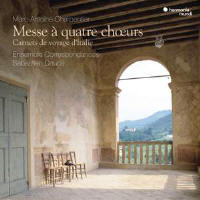Texte paru dans: / Appeared in: Harmonia Mundi |
|
|
Outil de traduction (Très approximatif) |
|
|
Reviewer:
Richard Lawrence The subtitle of this disc is ‘An Italian travel diary’. In the mid-1660s the young Charpentier spent about three years in Rome, where he studied with Carissimi. The details aren’t known, but the assumption here is that he would have broken the long journey from Paris by stopping in some of those Italian cities that had a strong musical tradition. It’s not London to Birmingham via Beachy Head, but Venice would have meant quite a detour. However, any excuse will do for programming this splendid Magnificat by Cavalli, which was published in 1656. It’s scored for two fourpart choirs – reinforced on this recording by instruments – and a third group of two violins and continuo. There is grandeur – solemn tutti chords for repetitions of ‘omnes’ (‘all generations’) – but what’s really appealing is the detailed wordpainting, as presented by Ensemble Correspondances. The proud are scattered almost skittishly, the mighty are put down gently, and the hungry are filled briskly and cheerfully. The choir numbers only 18 but the solo-tutti contrast comes across well. The Magnificat is preceded by Cavalli’s Sonata a 12 in D minor, two groups of strings, cornetts and sackbuts as it were flinging the phrases across the galleries of St Mark’s Basilica.
The first musical stop on this putative route is Cremona, the birthplace of
Monteverdi. Tarquinio Merula (d1665) was the maestro di cappella at the
cathedral. Credidi propter quod locutus sum is a Vespers psalm setting
for solo bass accompanied by two violins. The variations over a ground bass are
florid for both voice and instruments: Nicolas Brooymans negotiates them with
considerable vigour. On, then, to Bologna, where Maurizio Cazzati was the
maestro di cappella at San Petronio. Salve caput sacrosanctum,
published in 1669, is a motet in honour of the patron saint’s head, which was
buried there (it was joined by the rest of him some 20 years ago). More
antiphony here, from two six-part choirs, with the ear-teasing cross-rhythm of
the hemiola at the cadences. The Messe à quatre choeurs was probably composed in 1671, shortly after Charpentier’s return to Paris. Four choirs of four voices, but no 16-part counterpoint: Graham Sadler remarks in his booklet note that there are never more than seven ‘real’ parts, ‘though’, he adds tellingly, ‘this compromise makes little difference to the overall sound’. All the same, Charpentier had certainly assimilated the Italian polychoral style. The highlights include a chirpy ‘Qui sedes’ in the Gloria, kicked off by two sopranos; the assertive repetition of ‘non, non, non’ in the Credo’s ‘cujus regni’; and a jolly, syncopated Agnus Dei. Charpentier plunges straight into the Gloria but the Credo starts at ‘Patrem omnipotentem’, so of course there’s a plainsong intonation. Sebastien Daucé and his ensemble put all this together skilfully and beautifully, and the recorded sound is excellent. I enjoyed accompanying Charpentier on his journey and so, I’m sure, will you. |
|




